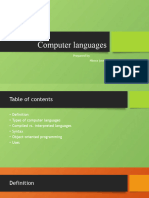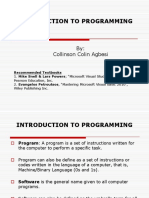0% found this document useful (0 votes)
6 views10 pagesInformative Programming Languages Presentation
The document provides an introduction to computer languages, explaining their role in communicating with computers and developing software. It outlines the types of programming languages, popular examples, and the process of how they work, emphasizing the benefits of learning programming. Additionally, it highlights the historical context of programming languages and encourages engagement with coding.
Uploaded by
knayanthara4Copyright
© © All Rights Reserved
We take content rights seriously. If you suspect this is your content, claim it here.
Available Formats
Download as PPTX, PDF, TXT or read online on Scribd
0% found this document useful (0 votes)
6 views10 pagesInformative Programming Languages Presentation
The document provides an introduction to computer languages, explaining their role in communicating with computers and developing software. It outlines the types of programming languages, popular examples, and the process of how they work, emphasizing the benefits of learning programming. Additionally, it highlights the historical context of programming languages and encourages engagement with coding.
Uploaded by
knayanthara4Copyright
© © All Rights Reserved
We take content rights seriously. If you suspect this is your content, claim it here.
Available Formats
Download as PPTX, PDF, TXT or read online on Scribd
/ 10

























































